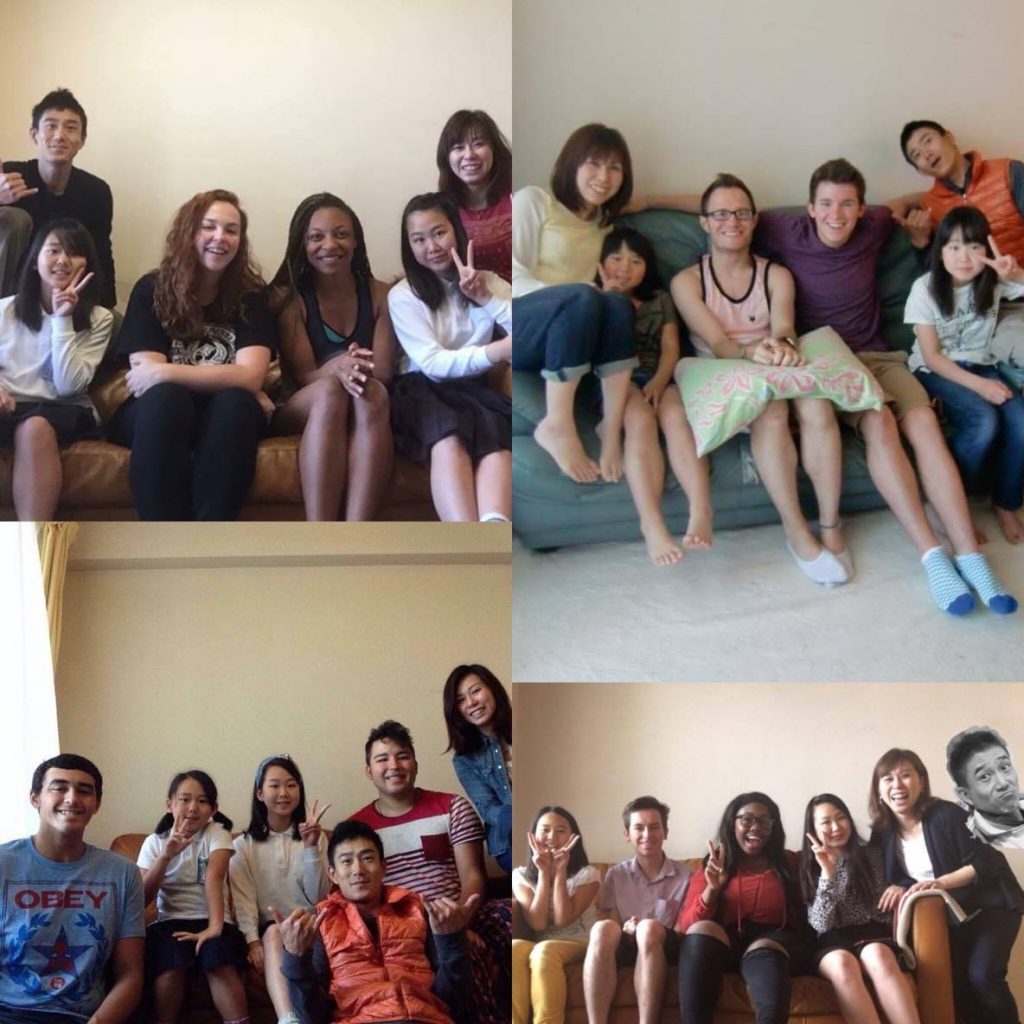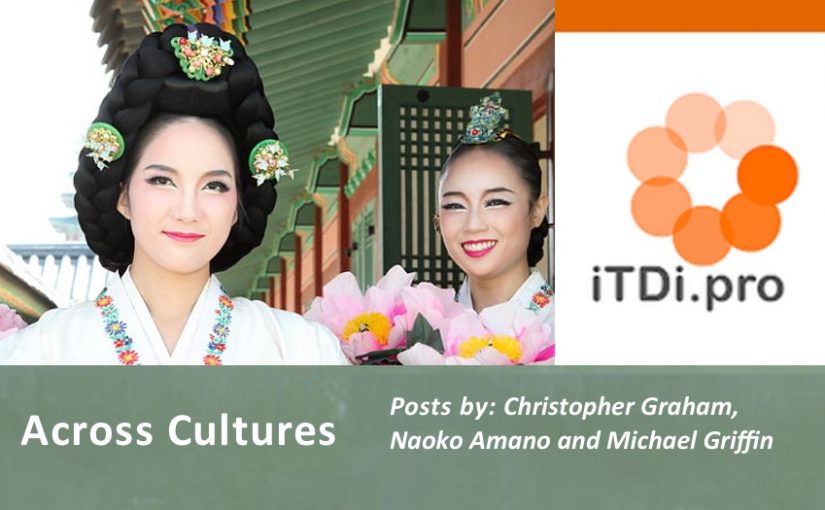Teaching English, or indeed any foreign language, goes hand in hand with teaching and learning about intercultural communication. In this month’s issue, Christopher Graham (the trainer of the upcoming iTDI Advanced Course, Intercultural Communication) explains how desire for cross-cultural communication can motivate students, Michael Griffin suggests a practical way to explore local cultures beyond stereotypes, and Naoko Amano shares her personal, passionate story of travelling across cultures while staying in Japan.
Category: Across Cultures
Late in Naples, or using cross-cultural awareness to motivate students

It was a hot summer day in Naples in Italy, some eight years or so ago. I was with an Italian colleague waiting to head to a meeting. I knew that the drive in a taxi was about 30 minutes and I also knew that the traffic would be bad. Yet she was showing no signs of getting ready to leave. I could feel that little knot of anxiety in my stomach becoming a larger knot of anger as we left to find a taxi just a few minutes before the meeting. Inevitably, we arrived late and some apologies were given but as I sat down at the meeting table, ready to start, I noticed that everyone else seemed to be, how can I put it, chatting. It was a frustrating day for me, but the meeting seemed to be a great success despite my stomach knots.
A moment of reflection might be appropriate at this point.
In Italy, particularly in the south, time is seen as a more fluid commodity than in northern Europe and it is more acceptable to arrive a little after the agreed time. As for the “chatting”, in many cultures, human relationships are held in higher regard than business transactions and the renewal or negotiation of these relationships is vital to successful interactions. Even if to other cultures it sounds like chatting. In my British culture, control of time is usually seen as a central part of our daily lives and our approach to work is more driven by the task than by the people.
I later had a “grown up” conversation with my colleague and took the opportunity to mention that, for me, going to a meeting late was like arriving with no trousers on. Her perfectly reasonable response was that my constant clock-watching and reminding made her feel breathless. Thus, compromises were reached. These conversations and the constructive engagement within them, it seems me, can help us manage these cultural differences and ensure smoother transactions in the future.
But what does all this have to do with English language teaching? When you’ve been working in the field for as long as I have, it becomes clear that, like all dynamic professions, English Language teaching has its trends. Ideas come, develop and stay, or sometimes wither and go. In my view, one of the most exciting areas to have emerged in (fairly) recent years is that of the integration of 21st century skills into our teaching. It’s hard to find a contemporary course book that doesn’t somewhere in the blurb profess to address these issues. For anyone uncertain, the areas covered by 21st century skills can be summarised under these four headings:
Critical Thinking and Problem Solving;
Collaboration and Communication;
Creativity and Imagination;
Citizenship.
The aspect of 21st century skills that has always fascinated me the most is that of cross-cultural awareness, an area that sits under the second heading above. From personal experience working and running ELT projects in over 20 countries, I know how important this aspect of communication is. I consider myself to be reasonably culturally literate but I still sometimes find myself coming (almost) unstuck in my travels and encounters around the world, such as in the Naples story above.
Stories such as mine are anecdotal, yes, but these can be very awkward situations with serious consequences for commercial or other relationships if a degree of empathy and understanding is not achieved. There is in fact a significant body of theory that can help us to make sense of cross-cultural situations and allow us to anticipate the behaviours of others and, where required, modify how we behave.
Cross-cultural communication is most certainly a 21st century skill, and teaching an awareness of it falls within our roles as teachers of adults or young adults. We are, after all, preparing our students for the real world, and that real world is where in business, science, and education Japanese people collaborate with Brazilians and Germans negotiate with Omanis. We need to teach not only the language but also the broader communicative context.
Self-awareness is perhaps the key to cross-cultural fluency. Classroom activities that encourage learners to reflect on their own culture and on how they are viewed by others can sometimes provide that magic “what” – the content – that students need to feel a desire to communicate.
If things close to the heart are they key to stimulating communication, what could be better than your own culture?
Across cultures through passion for music and dance

Do you know about the Young Americans?
About 8 years ago, I found an interesting blog. The author was writing about an event her daughter joined every year – singing and dancing with about 200 kids and about 40 young people from America. From her posts, I understood that the workshops were very exciting and everyone enjoyed the time very much. That is how I learnt about the Young Americans. It is a “charitable organization dedicated to the promotion of understanding and goodwill among people throughout the world through the world music, dance, performance, academic education, and the cultural interaction among students members and their audience” (you can find out more on their website).
As I read more about their work, I realized that they have several international music outreach programs and that is what anyone can join in Japan. I read more blog posts and articles about the Young Americans and I wanted to let my daughters have this experience.
Two years later, the time finally come. My daughters were 6 and 8 years old then. They didn’t have any idea about who the Young Americans were and what they did, and to be honest, I didn’t know well either. I just wanted my daughters to enjoy the two-day singing and dancing workshop in a foreign language environment. I cannot forget the way they were staring at me with their distraught eyes when they entered the hall for the first time. We said goodbye at 9 a.m. and then I picked them up at 7 p.m. It was a long day, but when I saw their bright shining eyes, I knew it went more than well. They were so excited and could hardly wait until the next day! The next day was the final day when the kids performed what they’d learnt for their families and friends. Imagine 200 children on the stage, dancing with all their effort, confidently, with a proud look on their faces. It was truly beautiful. I was moved to tears! It was hard to believe that they made their show in just two days, but it was true, and my daughters looked so happy. Since then, they have joined the workshop every year.
The big part of the workshop’s success, to my mind, is the way these young people, professionals at what they are doing, offer support and kind words to any child. Once I had an opportunity to see that for myself. Parents are welcome to observe the classes. I was curious about what’s going on during the workshop and wanted to know how they can bring out the hidden talent and so much positive energy in the kids. So this year I took a dance lesson and a performance lesson together with my girls. I saw for myself that at that workshop that the Young Americans provide the comfortable space where participants don’t have to be worried about other people or be nervous. They keep encouraging, pushing children by saying “You can do it!” – and when the kids brave up and do it, their young dancing coaches find just the right words of praise that seem to be coming from their hearts. So even among foreigners and at such vulnerable moments, the children feel safe and comfortable and happily try even harder!
Another interesting point about this experience is hosting the performers. The cast of the Young Americans stay at students’ houses for the duration of the workshops. According to them, they stay with about 40 different families during a four-month tour! My family has offered homestay four times and we see it as a great opportunity to communicate with the members of the team in a more relaxed and informal setting, as well as share about our cultures. At first, we were all very nervous, both kids and adults in my family – it was a new experience for us and we all had to find ways to communicate with each other. However, my daughters and the Americans we hosted became good friends really quickly. We talked about music and dancing, family and travelling, Japan and the USA. The so-called “culture exchange” happened spontaneously and very naturally. For example, my teenage daughter taught American twenty-year-olds how to play kendo (a type of Japanese martial arts) and cooked Japanese food for all of us; the boys we hosted taught my daughter how to play the guitar and how to make peanut butter and jelly sandwiches. It was difficult to explain many things in English, but my kids tried to do that using a mobile dictionary application. Even though it is always a very short time that we get to spend together, every time we learn some English that we cannot find in a textbook. For example, in school my kids were taught to say “You’re welcome” in response to a “Thank you,” but some of the young Americans we hosted said “Of course!” which was new for all of us. Another unusual example was that one girl kept calling my daughter “sis”! It is really interesting to learn daily expressions outside of the textbook. This simple communicative English is important and not so easy to find in a regular English class in Japan, so we appreciated the opportunity.
There are a few lessons I’ve learnt with this experience – most importantly, how open communication and kindness can affect or children. I value the time I spend with my kids as a parent, and I value each lesson I spend with my students as a teacher. I encourage my daughters with much love to help them have positive self-esteem. I keep encouraging my students from the bottom of my heart and tell them why I think it is important. By praising them a lot, I show respect and I hope that this will make them feel safe and be proud of themselves. I hope that my children and my students will learn to respect all people whatever culture they come from and enjoy our differences.

Exploring local culture beyond festivals and food

At the Seoul KOTESOL conference in 2014 Sandra Lee McKay said something along the lines of, “The main reason students learn English is to explain aspects of their culture to people from other cultures.” The audience nodded in approval but my friend sitting next to me scoffed and suggested under her breath there are more common and powerful reasons for learning English (especially in Korea), starting perhaps with parental and societal pressure.

Around the same time as that conference I had a chat with a student of mine (a grad student in an interpretation and translation program), who was distraught about her recent work experience in the field as an interpreter. The interpreting was fine for her and she felt comfortable with it. What troubled her was all the questions her clients asked her about Korea and Korean culture when not in the meeting room. She felt like she wasn’t familiar enough with aspects of Korean culture that non-Koreans might be interested in and curious about. She thought she lacked the knowledge, experience, and understanding to help explain such things to her clients.
Both the above examples influenced my thinking about explaining one’s own culture and the importance of working on this in class. To be very honest, I found my student’s experience more compelling than McKay’s assertion and I decided to include a bit more focus on cultural and intercultural aspects in my classes. In various classes (where I happen to have both Korean and non-Korean students) I started collecting a list of cultural aspects that might be interesting or surprising to non-Koreans. This list ranges from neon crosses above churches, to scissors for cooking to sauna protocol and can be found on my personal blog. After I had a substantial collection of cultural aspects, I decided to use it in class and what follows is a rough sketch of how I’ve used the list and the idea to focus on explaining aspects of Korean culture in my classes.
- I started by sharing the heart-wrenching story of their predecessor who struggled with explaining aspects of Korean culture to her clients and explained this was the reason I chose to do this lesson. I might have overly dramatized the story in an attempt to turn it into a tear-jerker, as well as solid proof that the coming lesson was based on filling that need.
- I told students I’d collected a list of cultural aspects that previous classes (both Korean and non-Korean) had suggested were “unique aspects of Korean culture” and asked them to guess what might be on the list. Students’ interest seemed to be piqued and they were ready to make some guesses.
- I took individual guesses and wrote them on the board in two columns. One column was for items which appeared on the original list and one was for those that didn’t.
- After there were a few guesses on the board, I asked students to think of 3-5 of their own guesses for what would be on the list and then to share with a partner. This naturally led to some explanation of the aspects, as well as to discussions on why they thought it might be interesting.
- I collected more guesses and populated the two columns on the board.
- I asked students to look at each column in turn and discuss with a (new) partner what appeared on the board. Students were asked to consider the following questions:
What is that?
What does it mean?
Why might it be surprising/interesting/confusing?
Why does it appear on this list?
Do you think it is unique to Korea?
7. While students were doing step 5, I quickly edited my original list of cultural aspects to make sure there were no duplicates between that list and the columns on the board.
8. I then set up a mini-role play where one student pretended to be non-Korean and their (new) partner explained items from the first column to the best of their ability. I encouraged those playing non-Koreans to be inquisitive and to ask as many questions as possible.
9. After the round of questions and explanations there was a bit of error correction and a group discussion about good and better ways to explain things that were challenging. An option at this point is to give some examples of language (for example, vague language or language for sharing opinions) that might be useful as students explain things.
10. We repeated steps 6 and 8 (and then 9) with the aspects found on my original list. This was done in stages, so students had chances to explain and ask. They changed partners throughout and everyone had an equal chance to play the explainer.
11. To wrap up, I took the opportunity to ask some questions to the whole group about certain aspects that seemed tricky to explain or seemed to have generated interest. I also gave students a chance to have me act as the explainer as they made sure I didn’t give any incorrect information.
I think the fact that the original list wasn’t created by me (or a mass produced textbook) helped generate interest and also gave students room to decide that certain aspects didn’t need to be discussed in detail. I told students to only ask their classmates about things they thought were worth asking about. I also encouraged those playing the non-Korean role to be very confused and ask lots of follow-up questions.
In the hope the role-play didn’t get uncomfortable or turn into the non-Korean trashing Korean culture and the Korean persona defending things, I tried to keep the focus on interesting or surprising aspects rather than on the negative. I tried to maintain an atmosphere of curiosity rather than judgment.
The above is, of course, just one simple idea and I am sure there are plenty of more sophisticated and nuanced ways to explore these issues. I’m hoping to learn more about Intercultural Communication in ELT through Christopher Graham’s upcoming iTDi course. I’d also love to see further suggestions, modifications or ideas related to the above in the comments to this post.






